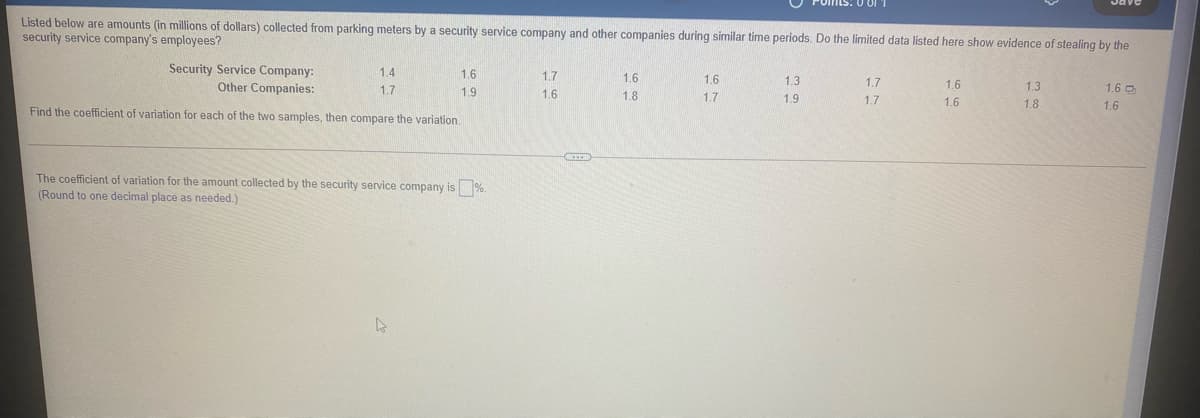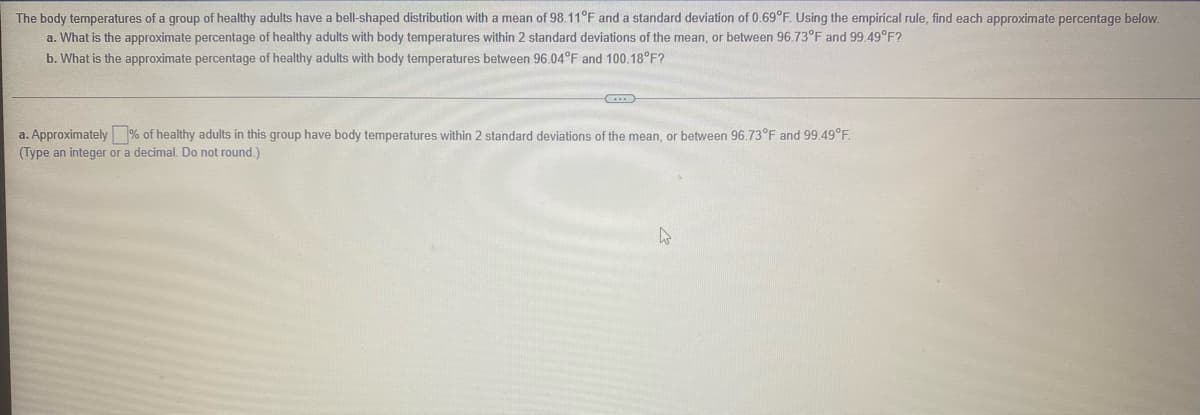Listed below are amounts (in millions of dollars) collected from parking meters by a security service company and other companies during similar time periods. Do the limited data listed here show evidence of stealing by the security service company's employees? Security Service Company: Other Companies: 14 1.6 1.7 1.6 1.6 1.3 1.7 1.6 1.3 1.6 o 1.7 1.9 1.6 1.8 1.7 1.9 1.7 1.6 1.8 1.6 Find the coefficient of variation for each of the two samples, then compare the variation.
Listed below are amounts (in millions of dollars) collected from parking meters by a security service company and other companies during similar time periods. Do the limited data listed here show evidence of stealing by the security service company's employees? Security Service Company: Other Companies: 14 1.6 1.7 1.6 1.6 1.3 1.7 1.6 1.3 1.6 o 1.7 1.9 1.6 1.8 1.7 1.9 1.7 1.6 1.8 1.6 Find the coefficient of variation for each of the two samples, then compare the variation.
Glencoe Algebra 1, Student Edition, 9780079039897, 0079039898, 2018
18th Edition
ISBN:9780079039897
Author:Carter
Publisher:Carter
Chapter4: Equations Of Linear Functions
Section: Chapter Questions
Problem 8SGR
Related questions
Question

Transcribed Image Text:Listed below are amounts (in millions of dollars) collected from parking meters by a security service company and other companies during similar time periods. Do the limited data listed here show evidence of stealing by the
security service company's employees?
Security Service Company:
1.4
1.6
1.7
1.6
1.6
1.3
Other Companies:
1.7
1.6
1.7
1.9
1.3
1.6 O
1.6
1.8
1.7
1.9
1.7
1.6
1.8
1.6
Find the coefficient of variation for each of the two samples, then compare the variation.
The coefficient of variation for the amount collected by the security service company is %.
(Round to one decimal place as needed.)

Transcribed Image Text:The body temperatures of a group of healthy adults have a bell-shaped distribution with a mean of 98.11°F and a standard deviation of 0.69°F. Using the empirical rule, find each approximate percentage below.
a. What is the approximate percentage of healthy adults with body temperatures within 2 standard deviations of the mean, or between 96.73°F and 99.49°F?
b. What is the approximate percentage of healthy adults with body temperatures between 96.04°F and 100.18°F?
a. Approximately % of healthy adults in this group have body temperatures within 2 standard deviations of the mean, or between 96.73°F and 99.49°F.
(Type an integer or a decimal. Do not round.)
Expert Solution
Step 1
Since you have asked multiple questions, we will solve the first question for you. If you want any specific question to be solved, then please specify the question number or post only that question.
Given:
| Security Service company | Other companies |
| 1.4 | 1.7 |
| 1.6 | 1.9 |
| 1.7 | 1.6 |
| 1.6 | 1.8 |
| 1.6 | 1.7 |
| 1.3 | 1.9 |
| 1.7 | 1.7 |
| 1.6 | 1.6 |
| 1.3 | 1.8 |
| 1.6 | 1.6 |
Step by step
Solved in 2 steps

Recommended textbooks for you

Glencoe Algebra 1, Student Edition, 9780079039897…
Algebra
ISBN:
9780079039897
Author:
Carter
Publisher:
McGraw Hill

Glencoe Algebra 1, Student Edition, 9780079039897…
Algebra
ISBN:
9780079039897
Author:
Carter
Publisher:
McGraw Hill